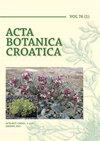辣椒疫霉胁迫下抗感植株对脯氨酸的生理反应
IF 0.7
4区 生物学
Q3 PLANT SCIENCES
引用次数: 0
摘要
辣椒疫霉;是限制辣椒产量的主要病原体。研究了抗性辣椒(CM-334)和易感辣椒(SD-8)幼苗在暴露前分别添加1和10 mM脯氨酸(Pro)对辣椒某些生理参数的影响。较低浓度Pro (1 mM)比10 mM Pro更能提高CM-334品种的抗逆性。在CM-334品种中,叶绿素a、叶绿素b、类胡萝卜素、葡萄糖和果糖含量以及1,1-二苯基-2-苦酰肼(DPPH)清除活性百分比在施用1 mM Pro +辣椒辣椒后第7天达到最高,丙二醛(MDA)清除活性百分比在施用1 mM Pro +辣椒辣椒后第3天达到最低。在施用10 mM Pro+辣椒的第7天,铁还原抗氧化能力(FRAP)提高最高。相同Pro处理对ssd -8品种的影响略有差异;叶绿素a、叶绿素b、花青素、果糖、总蛋白和内源Pro含量在1 mM Pro +辣椒粉处理后第7天最高,MDA含量在10 mM Pro +辣椒粉处理后第3天最低,DPPH %和FRAP值在10 mM Pro +辣椒粉处理后第7天最高。尽管不同品种间存在一定差异,但总体而言,施用Pro对辣椒的光合色素、可溶性碳水化合物和抗氧化能力均有积极影响。外源施用Pro有助于无抗性品种克服胁迫。本文章由计算机程序翻译,如有差异,请以英文原文为准。
Physiological responses of resistant and susceptible pepper plants to
exogenous proline application under Phytophthora capsici stress
Phytophthora capsici Leon. is the main pathogen that limits the production of peppers. In this study, the effects of 1 and 10 mM proline
(Pro), prior to exposure of resistant (CM-334) and susceptible (SD-8) pepper seedlings to P. capsici, on some physiological parameters were investigated. A lower Pro concentration (1 mM) was found to be more effective than 10 mM Pro in increasing the stress tolerance of the CM-334 cultivar. Namely, in CM-334 cultivar, the highest chlorophyll a, chlorophyll b, carotenoid, glucose and fructose content and 1,1-diphenyl-2-picrylhydrazyl (DPPH) scavenging activity percentage were
detected on the seventh day after application of 1 mM Pro + P. capsici,
while the lowest malondialdehyde (MDA) amount was measured on the third
day in the same treatment. The highest ferric reducing antioxidant power (FRAP) increase was determined on the seventh day in the 10 mM Pro
+ P. capsici application. The effects of the same Pro treatments on the
SD-8 cultivar somewhat differed; the highest amounts of chlorophyll a, chlorophyll b, anthocyanins, fructose, total protein and endogenous Pro were detected on the seventh day in the 1 mM Pro + P. capsici application, while the lowest MDA amount was measured on the third day after the 10 mM Pro + P. capsici application, the highest DPPH % and FRAP values were detected on the seventh day with 10 mM Pro + P. capsici
application. Although some differences were detected between the cultivars, Pro application against the P. capsici stress in general resulted in a positive effect on photosynthetic pigments, soluble carbohydrates and antioxidant capacity in pepper. The exogenous application of Pro helped the non-resistant cultivar to overcome the stress.
求助全文
通过发布文献求助,成功后即可免费获取论文全文。
去求助
来源期刊

Acta Botanica Croatica
PLANT SCIENCES-
CiteScore
2.50
自引率
0.00%
发文量
34
审稿时长
>12 weeks
期刊介绍:
The interest of the journal is field (terrestrial and aquatic) and experimental botany (including microorganisms, plant viruses, bacteria, unicellular algae), from subcellular level to ecosystems. The attention of the Journal is aimed to the research of karstic areas of the southern Europe, karstic waters and the Adriatic Sea (Mediterranean).
 求助内容:
求助内容: 应助结果提醒方式:
应助结果提醒方式:


